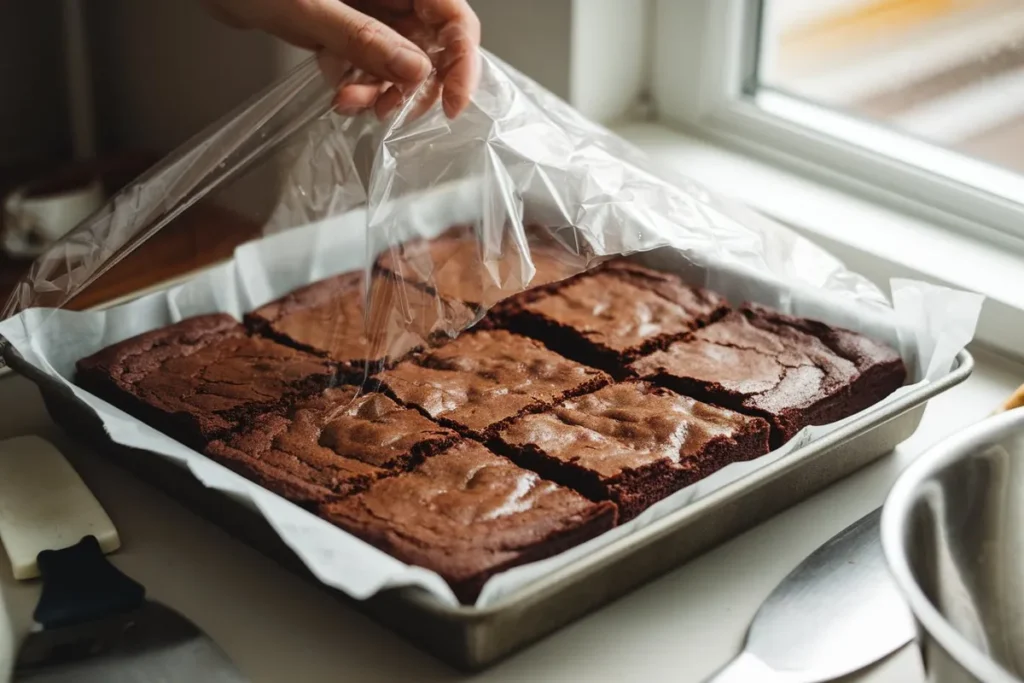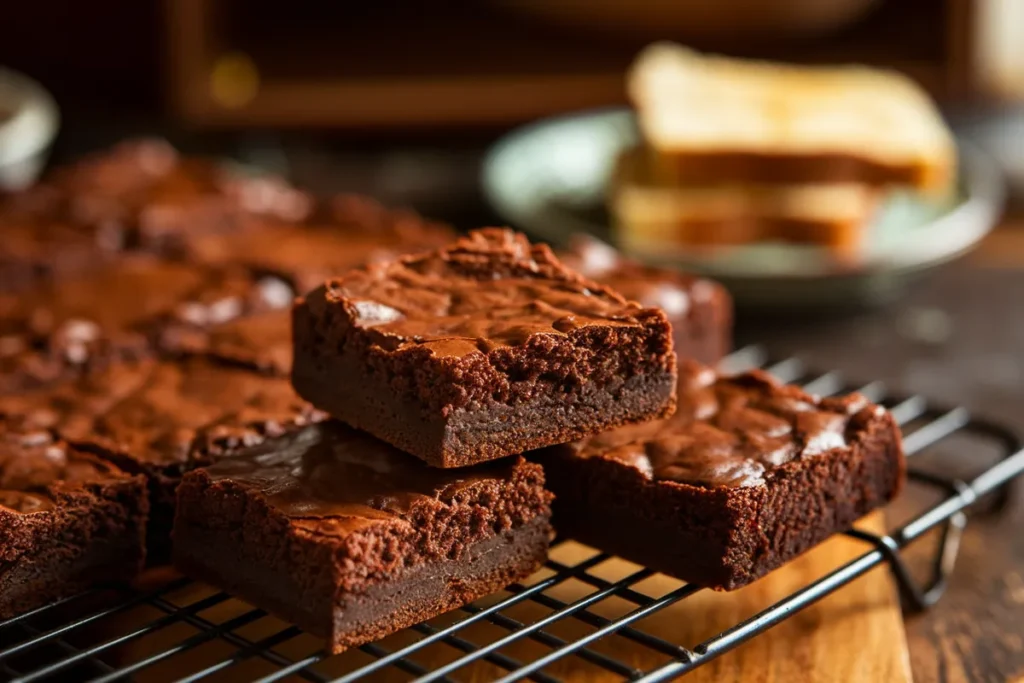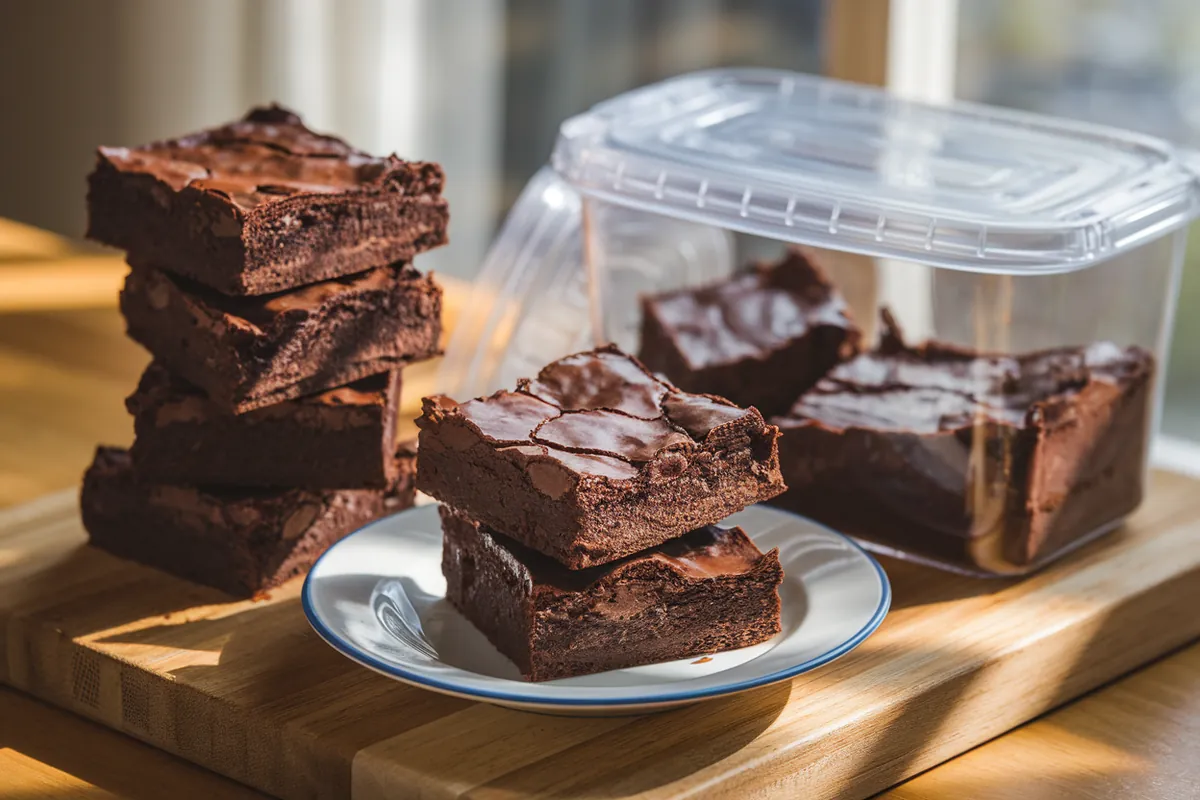Introduction
Brownies are a beloved dessert known for their rich, fudgy texture and deliciously satisfying flavor. However, one common problem many bakers face is how to Keep Brownies From Getting Hard over time. Whether you’re making a batch for a family gathering or to satisfy your sweet tooth, preventing them from becoming firm is crucial. In this guide, we’ll explore tips and tricks to maintain their soft, chewy, and delicious texture.
Understanding Why Brownies Get Hard
The first step in preventing brownies from becoming hard is understanding why it happens. Several factors can contribute to the hardening of brownies:
Overbaking: A Common Culprit
One of the most common reasons brownies become hard is overbaking. Even a few minutes too long in the oven can result in a dry, hard texture. Brownies are very sensitive to time and temperature, and even slight deviations can affect their texture. To avoid overbaking, it’s essential to set a timer and keep a close eye on the brownies during the last few minutes of baking. The edges should be set, but the center should still have some jiggle to it when you gently shake the pan.
The Impact of Pan Material
The material of the baking pan can significantly impact the texture of your brownies. Metal pans tend to conduct heat more efficiently than glass or silicone pans, which can lead to harder edges. Metal pans heat up quickly and evenly, which is great for achieving a crispy edge, but it can also result in hard, overcooked brownies if you’re not careful. Glass and silicone pans, on the other hand, heat more slowly and evenly, which can help prevent the edges from hardening too much.
Improper Storage: Losing Moisture Quickly
If not stored correctly, these treats can lose moisture quickly, leading to a hard, stale texture. Once exposed to air, they begin to dry out. To prevent this, it’s important to place them in an airtight container as soon as they have cooled completely. This will help lock in moisture and keep them soft and chewy.
Ingredient Proportions Matter
The ratios of ingredients, such as flour, sugar, and fat, play a vital role in the final texture of brownies. Incorrect proportions can lead to drier, harder results. For instance, too much flour can make brownies cakey and dry, while too much sugar can make them overly sweet and sticky. It’s important to follow the recipe closely and measure ingredients accurately to achieve the desired texture.
For those exploring different brownie recipes, understanding the key differences between cakey and fudgy brownies can help you choose a recipe that minimizes the chances of brownies getting hard.
The Role of Ingredients in Brownie Texture
Choosing the right ingredients and using them in the correct proportions is key to achieving soft, chewy brownies. Here are some ingredient-related tips to help you maintain the perfect texture:
Choosing the Right Flour
Different types of flour can affect the texture of brownies. Using all-purpose flour is generally recommended for a balanced texture. Too much flour can make brownies cakey and dry, while too little can result in overly fudgy brownies. If you prefer a chewier texture, try using a combination of all-purpose flour and bread flour, which has a higher protein content and will give the brownies a more substantial bite.
The Importance of Sugar Types
The type of sugar used can also impact the moisture content. Brown sugar adds more moisture and chewiness compared to white sugar, thanks to its molasses content. If you prefer a more caramel-like flavor in your brownies, try using a higher proportion of brown sugar to white sugar. You can also experiment with using other sweeteners, such as honey, maple syrup, or coconut sugar, to add depth and complexity to the flavor.
Balancing Fat Content
The choice between butter and oil can alter the texture. Butter adds flavor but can make brownies harder when cooled. Oil, on the other hand, keeps brownies moist and soft even after refrigeration. If you’re looking for a richer, more indulgent flavor, try using a combination of butter and oil. The butter will add a rich, creamy flavor, while the oil will keep the brownies moist and tender.
The Type of Chocolate Matters
The type and quality of chocolate used can greatly affect the texture and flavor of brownies. High-quality chocolate with a high cocoa content will give brownies a rich, intense flavor and a fudgy texture. You can use a combination of dark chocolate, milk chocolate, and cocoa powder to achieve the desired balance of sweetness and bitterness. If you prefer a sweeter, less intense flavor, try using semisweet or milk chocolate.
For more tips on choosing the right ingredients, you can check out this discussion on Quora about why the edges of brownies tend to harden.
Baking the Perfect Brownies
Baking is a science, and paying attention to every detail can make a huge difference in the final outcome of your brownies. Here are some tips to optimize the baking process:
Setting the Right Temperature
- Oven Temperature: Ensure your oven is preheated to the correct temperature before placing the brownies inside. Too high of a temperature can cause the edges to cook faster, leading to hard, dry brownies. To ensure even baking, place the pan in the center of the oven and avoid opening the oven door too frequently, as this can cause the temperature to fluctuate and affect the texture of the brownies.
Checking for Doneness

- Even Heat Distribution: Using an oven thermometer can help you maintain an accurate temperature. Additionally, rotating the pan halfway through baking can promote even cooking and prevent the edges from hardening too much. If you’re using a convection oven, be sure to adjust the temperature and baking time accordingly, as convection ovens tend to cook food more quickly and evenly than conventional ovens.
- Bake Time: Always follow the recommended bake time for your recipe. Use a toothpick to check for doneness: if it comes out with a few moist crumbs, they are done. Overbaking by even a few minutes can result in a hard, dry texture. If you’re unsure, it’s better to slightly underbake them, as they will continue to cook and set as they cool.
Mixing the Ingredients
- Mixing Technique: The way you mix the ingredients can also affect the final texture. Overmixing can lead to a tough, dense result, while undermixing might cause uneven baking and a coarse texture. To avoid these issues, mix the ingredients just until they are combined, and be careful not to overmix the batter.
For more information on keeping brownies soft during baking, refer to this useful guide.
Choosing the Right Pan for Brownies
The choice of pan can make a big difference in the texture of these treats. Here’s what to consider:
Metal Pans: These conduct heat quickly and efficiently, which can lead to harder edges. If you prefer a softer texture, reduce the baking time slightly when using metal pans. They are great for achieving a crispy edge and a gooey center, but be sure to keep a close eye on them to avoid overbaking.
Glass Pans: These heat more slowly and evenly, which can help prevent the edges from hardening too much. However, glass retains heat longer, so the dessert may continue to bake after being removed from the oven. To prevent overbaking, consider reducing the oven temperature by 25 degrees Fahrenheit when using a glass pan.
Silicone Pans: These are great for maintaining moisture, as they conduct heat less efficiently. Silicone pans are an excellent choice if you consistently struggle with making them too hard. They are also non-stick, making it easy to remove the treats from the pan without damaging them.
Using parchment paper to line the pan can also help keep the treats from sticking and promote even cooking. Parchment paper creates a barrier between the batter and the pan, helping to prevent overcooking and sticking. brownies and the pan, preventing the edges from cooking too quickly and becoming hard.
How to Store Brownies to Keep Them Soft
Even after perfect baking, improper handling post-baking can cause brownies to harden. Here are some best practices:
Cooling Brownies Correctly
- Proper Cooling: Allow brownies to cool in the pan for a few minutes before transferring them to a wire rack. This prevents steam from escaping too quickly, which can lead to dryness. Cooling the brownies in the pan also allows them to set and firm up, making them easier to cut and serve.
Storing Brownies to Retain Moisture
- Wrapping and Storing: Wrap brownies tightly in plastic wrap or store them in an airtight container to retain moisture. Adding a slice of bread to the container can also help keep them soft. The bread will absorb any excess moisture, preventing the brownies from becoming soggy.
- Avoid Refrigeration: Storing brownies in the refrigerator can cause them to dry out and harden. If you must refrigerate, make sure they are well-wrapped to minimize moisture loss. To restore the softness of refrigerated brownies, let them come to room temperature before serving, or warm them in the microwave for a few seconds.
For more detailed strategies on keeping brownies soft and chewy, refer to the guide on how to keep brownies soft and chewy on Avery Recipes.
Freezing Brownies for Freshness

If you’ve baked a large batch and want to enjoy them over time, freezing is a great option. Here’s how to do it right:
- Wrap Individual Portions: Wrap each brownie individually in plastic wrap to prevent freezer burn and maintain moisture. Wrapping brownies individually also makes it easy to grab a single serving whenever you want a quick treat.
- Use an Airtight Container: Place the wrapped treats in an airtight container or freezer bag for added protection. This will help prevent them from absorbing any odors or flavors from the freezer.
- Thawing and Reheating: To enjoy frozen brownies, let them thaw at room temperature or warm them in the microwave for a few seconds. You can also enjoy frozen brownies straight from the freezer for a cool, chewy treat.
Frequently Asked Questions (FAQs)
Why do the edges of my brownies get hard?
The edges often become firm due to overbaking and higher heat concentration on the pan’s edges. Using a silicone or glass pan can help reduce this effect.
How do I keep them from hardening overnight?
To keep them soft, store them in an airtight container, wrapped in plastic wrap. Adding a slice of bread to the container can also help maintain moisture.
Can I soften brownies that have become hard?
Yes, you can make them softer by placing a damp paper towel over them and microwaving for a few seconds. Another method is to warm them in a low oven for a few minutes to restore their softness.
How long do they stay fresh?
When stored properly in an airtight container, they can stay fresh for up to a week. For longer storage, freezing is recommended.
